标签:字符 use else back 数组名 height 下标 char print
ex2_1_1
// 形参是数组,实参是数组名
#include <stdio.h>
#include <stdlib.h>
const int N=5;
int binarySearch(int x[], int n, int item); // 函数声明
int main() {
int a[N]={2,7,19,45,66};
int i,index, key;
printf("数组a中的数据:\n");
for(i=0;i<N;i++)
printf("%d ",a[i]);
printf("\n");
printf("输入待查找的数据项: ");
scanf("%d", &key);
// 调用函数binarySearch()在数组a中查找指定数据项item,并返回查找结果给index
// 补足代码①
// ×××
index=binarySearch(a,N,key);
if(index>=0)
printf("%d在数组中,下标为%d\n", key, index);
else
printf("%d不在数组中\n", key);
system("pause");
return 0;
}
//函数功能描述:
//使用二分查找算法在数组x中查找特定值item,数组x大小为n
// 如果找到,返回其下标
// 如果没找到,返回-1
int binarySearch(int x[], int n, int item) {
int low, high, mid;
low = 0;
high = n-1;
while(low <= high) {
mid = (low+high)/2;
if (item == x[mid])
return mid;
else if(item<high)
high = mid - 1;
else
low = mid + 1;
}
return -1;
}
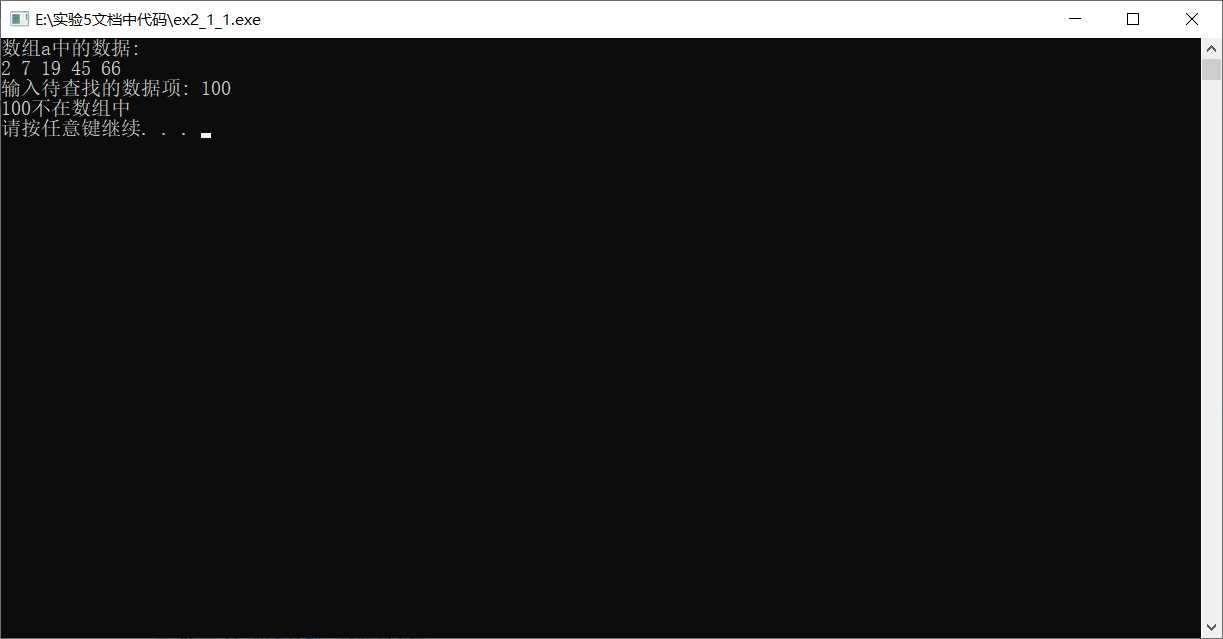
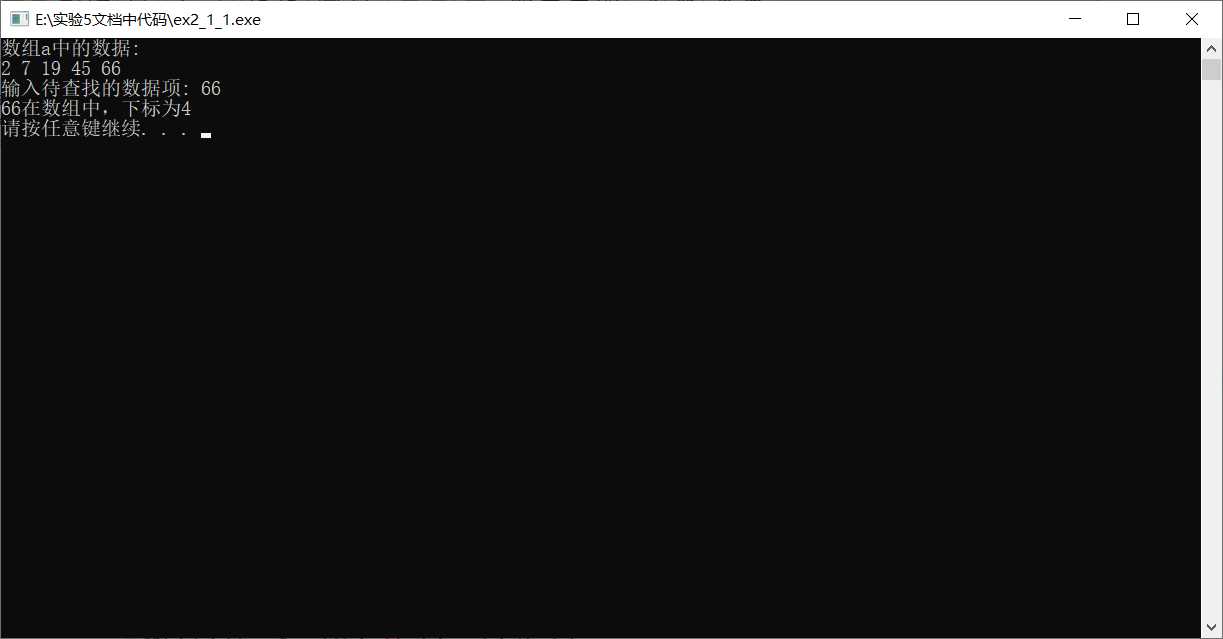
ex2_1_2
/*
N个字典序的整数已放在一维数组中,给定下列程序中,函数fun的功能是:
利用折半查找算法查找整数m在数组中的位置。
若找到,则返回其下标值;反之,则返回-1
*/
#include <stdio.h>
#include <stdlib.h>
#define N 10
int fun(int *a,int m)
{
int low = 0, high = N-1, mid;
/*************ERROR**************/
while(low <= high)
{
mid = (low+high)/2;
/*************ERROR**************/
if(m < *(a+mid))
high = mid-1;
/*************ERROR**************/
else if(m > *(a+mid))
low = mid+1;
else
return(mid);
}
return(-1);
}
int main()
{
int i,a[N]={-3,4,7,9,13,24,67,89,100,180},k,m;
printf("a数组中的数据如下:\n");
for(i=0;i<N;i++)
printf("%d ",a[i]);
printf("\nEnter m: \n");
scanf("%d",&m);
/*************ERROR**************/
k = fun(a,m);
if (k>=0)
printf("m=%d,index=%d\n",m,k);
else
printf("Not be found!\n");
system("pause");
return 0;
}
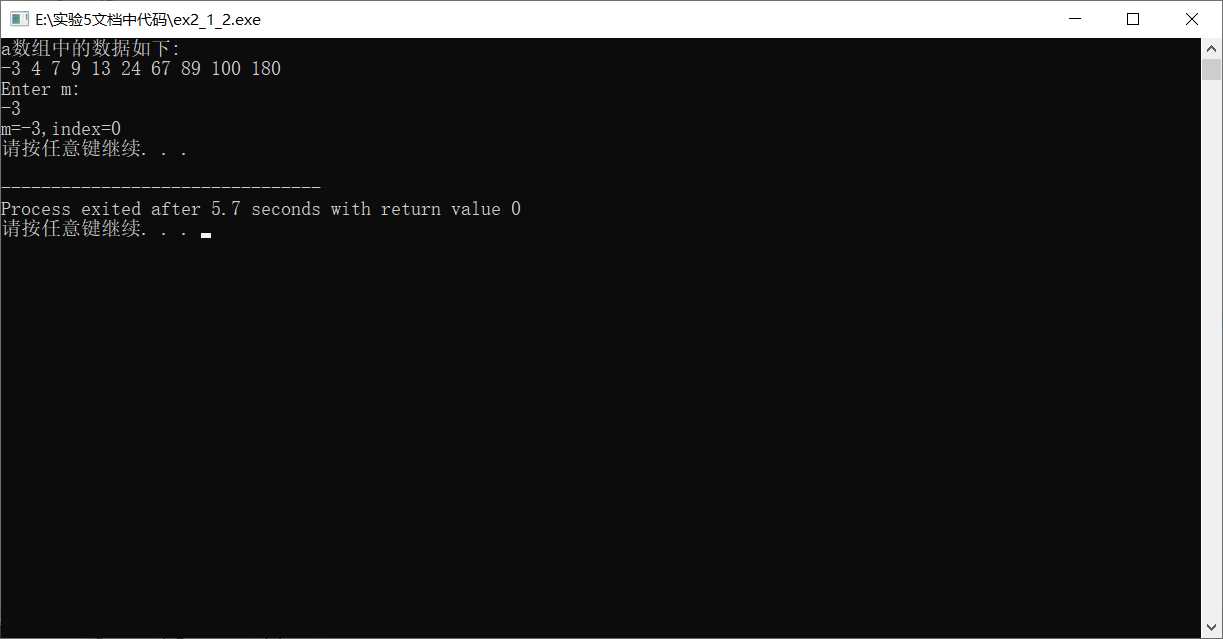
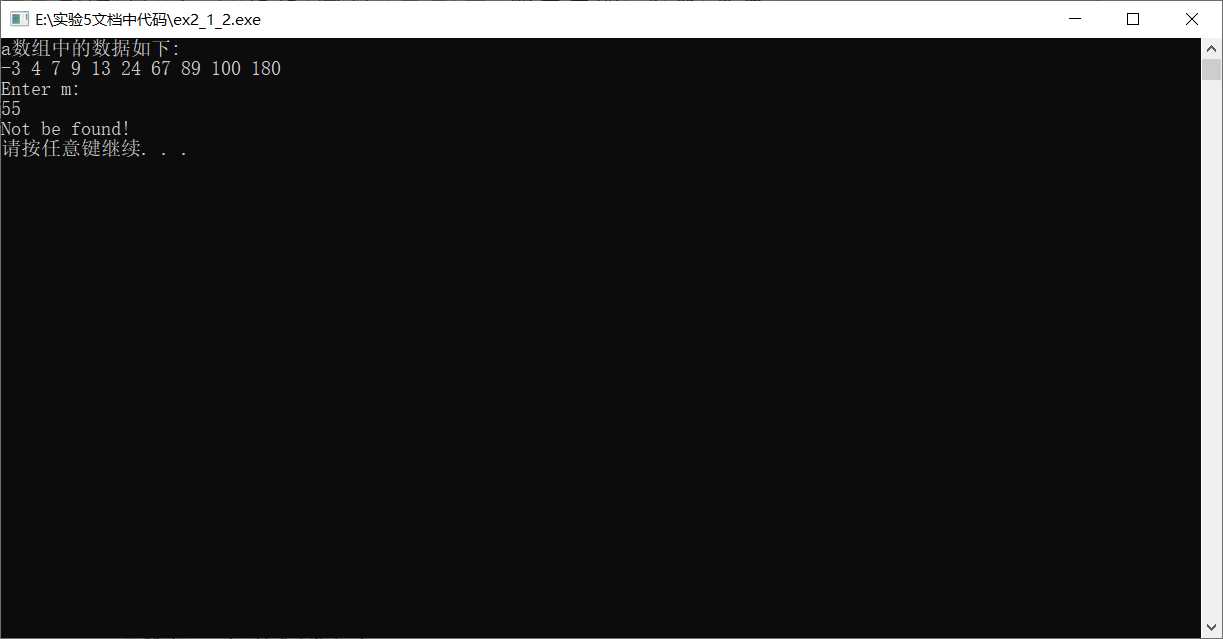
ex2_2_2
// 练习:使用选择法对字符串按字典序排序
#include <stdio.h>
#include <string.h>
#include <stdlib.h>
void selectSort(char str[][20], int n ); // 函数声明,形参str是二维数组名
int main() {
char name[][20] = {"John", "Alex", "Joseph", "Taylor", "George"};
int i;
printf("输出初始名单:\n");
for(i=0; i<5; i++)
printf("%s\n", name[i]);
selectSort(name, 5); // 调用选择法对name数组中的字符串排序
printf("按字典序输出名单:\n");
for(i=0; i<5; i++)
printf("%s\n", name[i]);
system("pause");
return 0;
}
// 函数定义
// 函数功能描述:使用选择法对二维数组str中的n个字符串按字典序排序
void selectSort(char str[][20], int n) {
// 补足代码
// ×××
int i,j,p;
char name[20];
for(i=0;i<n-1;i++)
{
p=i;
for(j=i+1;j<n;j++)
{
if(strcmp(str[p],str[j])>0)
p=j;
}
if(p!=i)
{
strcpy(name,str[i]);
strcpy(str[i],str[p]);
strcpy(str[p],name);
}
}
}

ex2_3_1
/*
假定输入的字符串中只包含字母和*号。
编写函数,实现:
除了字符串前导的*号之外,将串中其他*号全部删除。
在编写函数时,不得使用C语言提供的字符串函数。
例如,若字符串中的内容为****A*BC*DEF*G*******
删除后,字符串中的内容则应当是****ABCDEFG
*/
#include <string.h>
#include <stdio.h>
#include <stdlib.h>
void fun(char *a) {
/*****ERROR********/
int i=0;
char *p = a;
/****ERROR***/
while(*p && *p == ‘*‘) {
a[i] = *p;
i++;
p++;
}
while(*p) {
/******ERROR*******/
if(*p != ‘*‘) {
a[i] = *p;
i++;
}
p++;
}
/******ERROR*******/
a[i] = 0;
}
int main() {
char s[81];
printf("Enter a string :\n");
gets(s);
/***ERROR******/
fun(s);
printf("The string after deleted:\n");
puts(s);
system("pause");
return 0;
}
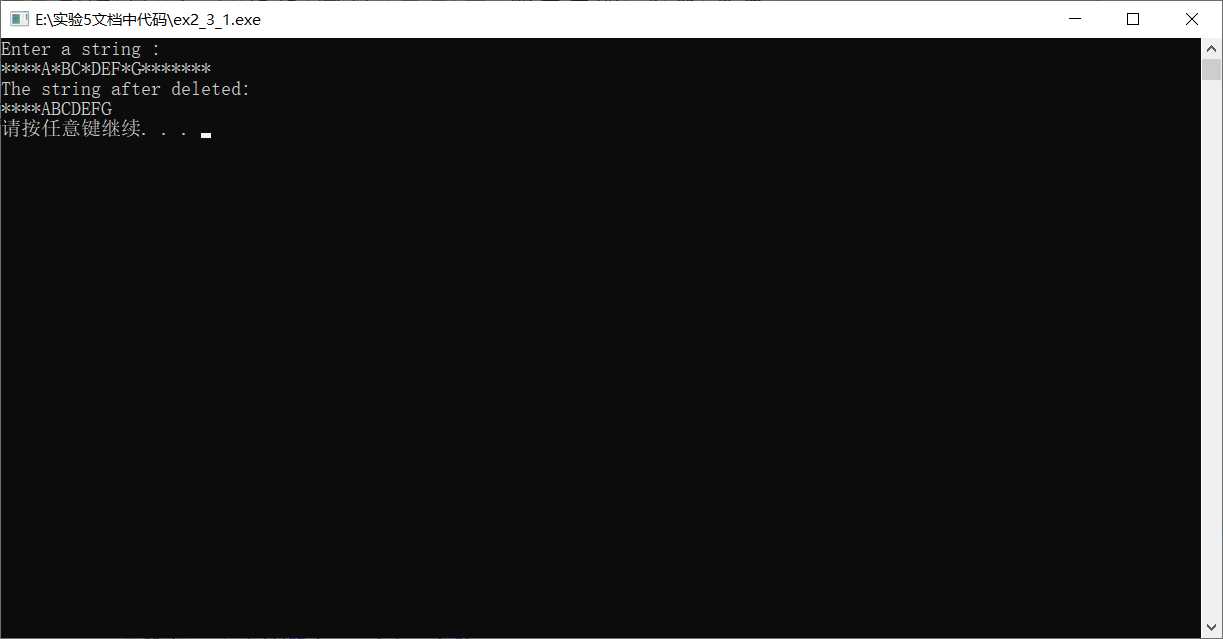
ex2_3_2
/*
假定输入的字符串中只包含字母和*号。
编写函数,实现:
除了字符串前导和尾部的*号之外,将串中其他*号全部删除。
在编写函数时,不得使用C语言提供的字符串函数。
例如,若字符串中的内容为****A*BC*DEF*G*******
删除后,字符串中的内容则应当是****ABCDEFG******
*/
#include <stdio.h>
#include <stdlib.h>
#include <string.h>
void fun(char *a) {
/**ERROR******/
int i=0;
char *t = a, *f = a;
char *q = a;
while(*t)
t++;
t--;
while(*t == ‘*‘)
t--;
while(*f == ‘*‘)
f++;
/***ERROR***/
while (q<f) {
a[i] = *q;
q++;
i++;
}
while (q<t) {
/***ERROR**/
if(*q != ‘*‘) {
a[i] = *q;
i++;
}
q++;
}
while (*q) {
a[i] = *q;
i++;
q++;
}
/**ERROR**/
a[i]!=0;
}
int main () {
char s[81];
printf("Entre a string:\n");
gets(s);
/**ERROR**/
fun(s);
printf("The sting after deleted:\n");
puts(s);
system("pause");
return 0;
}
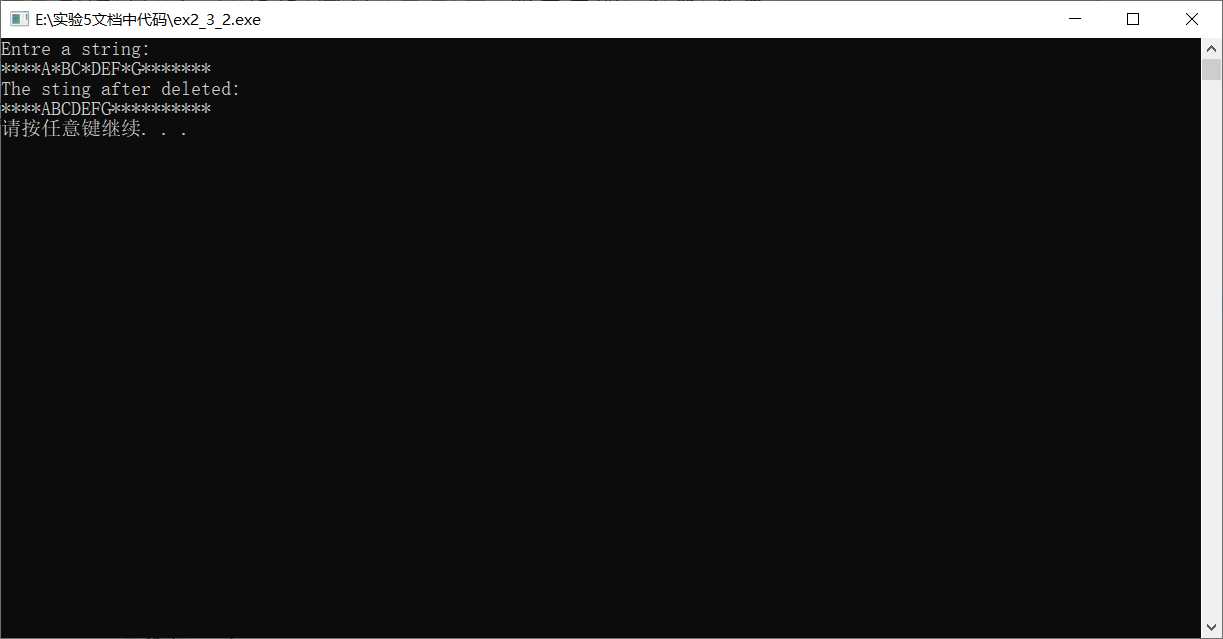
标签:字符 use else back 数组名 height 下标 char print
原文地址:https://www.cnblogs.com/ttkk/p/12045022.html